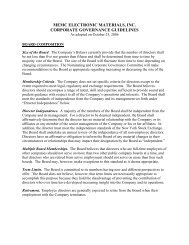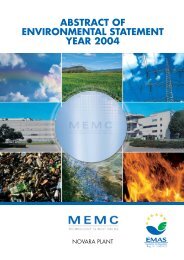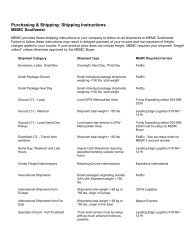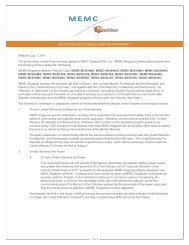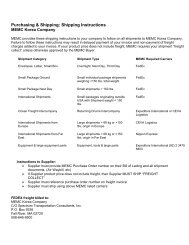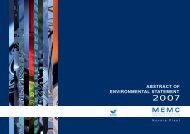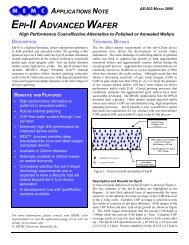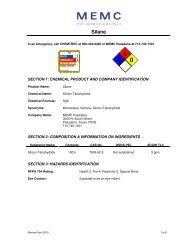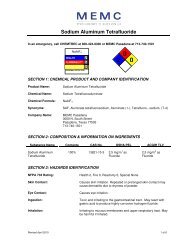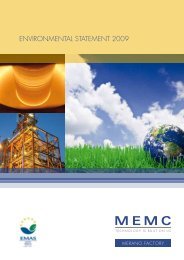BUILDING ON THE PAST, READY FOR THE FUTURE: - MEMC
BUILDING ON THE PAST, READY FOR THE FUTURE: - MEMC
BUILDING ON THE PAST, READY FOR THE FUTURE: - MEMC
Create successful ePaper yourself
Turn your PDF publications into a flip-book with our unique Google optimized e-Paper software.
66<br />
2002<br />
worldwide<br />
semiconductor<br />
materials sales reach<br />
$21 billion, exceeding<br />
the size of the<br />
equipment market for<br />
the first time.<br />
2003<br />
Satellite radio is<br />
invented.<br />
2004<br />
300mm capacity<br />
exceeds 100,000<br />
wafers per month.<br />
2005<br />
300mm wafers go into<br />
production in Taiwan.<br />
2006<br />
<strong>MEMC</strong> announces $5-6<br />
billion agreement to<br />
supply Suntech Power<br />
Holdings Company<br />
with solar-grade<br />
silicon wafers.<br />
<strong>MEMC</strong> enters into an<br />
agreement with Silicon<br />
Genesis Corporation to<br />
manufacture SOI wafers<br />
using their layer transfer<br />
technology.<br />
Despite the gloomy conditions, <strong>MEMC</strong><br />
continued to position itself for the time<br />
when the market would turn around. In<br />
March 1997, the first phase of the 300mm<br />
research and development line at St. Peters<br />
was completed, and 300mm wafers were<br />
being shipped to customers worldwide.<br />
Additional investments in the Utsunomiya,<br />
Japan, facility, totaling some $250 million,<br />
were announced in October of 1997.<br />
transForMatIon<br />
Ludger H. Viefhues was named president<br />
and CEO succeeding Roger McDaniel in<br />
1996. He immediately launched a companywide<br />
program called Transformation to<br />
shore up <strong>MEMC</strong>’s competitive advantage.<br />
Calling on employees throughout the<br />
company, the goal of the Transformation<br />
was to examine all policies, procedures,<br />
and practices on a functional, rather than<br />
regional, basis. Teams were organized,<br />
locally and globally, and were asked to<br />
“stick their oars in the water and row in the<br />
same direction.”<br />
Customer Focus Teams investigated every<br />
aspect of customer service. No detail was<br />
too small for examination by Accelerated<br />
Cost Reduction Teams (ACRT). Reviews<br />
began on such items as the silicon waste<br />
that resulted from cutting ingots, improving<br />
packaging to minimize the “outgassing”<br />
effect on wafers, and so on. Blitz Teams<br />
were formed as cross-functional groups<br />
whose job it was to focus on one function<br />
and, without any capital expenditure,<br />
implement cost-cutting measures within<br />
five days. Global Best Practices conferences<br />
were launched as a continuation of the one<br />
initiated by the Cheonan, South Korea,<br />
plant back in 1996.<br />
Though these efforts ultimately proved<br />
to be productive, the challenges of over-



